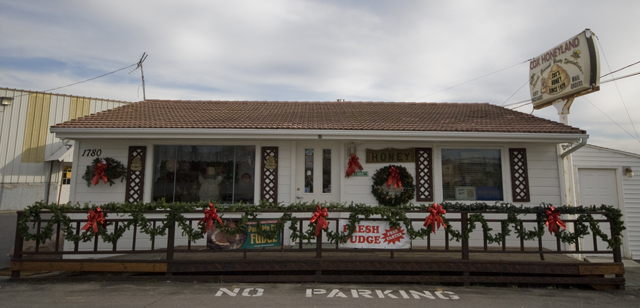A sweet business: Cox Honeyland
Maleesa Jackobsen’s family has been in the bee business since 1929 when her grandfather ventured from St. George further into Utah with a collection of bees. This led to four generations of bee keeping and honey making, as well as laying the foundation for Cache Valley’s very own Cox Honeyland.
Jackobsen said Cox Honeyland, a gift shop which sells 100 percent pure raw honey, holiday themed decorations and an assortment of sweets, was established in the late ’80s by her family. Before this time, Jackobsen’s family owned only bees and sold their honey directly to large corporations.
“In 1989 my mother decided to start marketing the honey instead,” said Jackobsen, who manages the gift shop.
“She thought she could do more with honey than sell it directly to mass distributors, so we’ve taken honey and made it into a gift.”
A quick visit to Cox Honeyland displays a wide range of gifts and honey-based products, including three types of honey. Among the three flavors of honey is roughly 12 varieties of creamed honey, caramel apples, as well as freshly made honey popcorn and fudge, and anyone is welcome to come in for a free sample, Jackobsen said.
The gift shop itself is also a sight to see. During the summer months there is a live beehive under glass in the rear of the shop which Jackobsen said she hopes educates people about bees and honey. The shop is jam-packed with gift items ranging from bees wax candles to holiday cards to finely crafted wooden clocks, she said. Jackobsen said they also customize gift baskets which many college students take advantage of.
But the gift shop only makes up a small portion of Cox Honeyland. Behind the gift shop, which looks like a one-story whitewashed house, there is a two-story warehouse that contains shelves of flavored honeys and treats. Here Jackobsen and her sister make the fudge and honey popcorn, as well as stash other items.
The warehouse also contains three 500-gallon tanks on the second floor filled with fresh honey. Each tank has a pipe that runs down to the first floor and pokes out of the wall, dripping with honey. This is where Jackobsen said she taps her honey, but also said anyone is welcome to come with their own jar and fill up.
“We’re not in the business of selling containers, we’re just here to sell honey,” Jackobsen said.
Between all of the customers who visit Cox Honeyland Jackobsen said they go through roughly 20,000 pounds of honey a month.
And Jackbosen said many people make the journey to their little shop from all over to get a taste of their honey.
“We have people come from Cache Valley, Idaho, Ogden and even further away some times. People drive from all over because we are a unique gift shop and unique gift shops are hard to find now,” Jackobsen said.
Jackobsen said she also delivers honey many times a week as far as Orem.
“We hand pack every order and deliver it to stores all across Utah,” she said. “A lot of the stores who want our honey are health food markets or people who know that honey is a good gift item.”
But shopping at Cox Honeyland isn’t just for those in search of a novelty gift item. Jackobsen said their honey is also extremely healthy and does not contain additives like most honey found at the grocery store.
“Honey from the grocery store isn’t comparable to what we sell here because a lot of big packers with honey do not sell a pure product that crystallizes. They can add things to it without it being labeled that way. Our honey is thick and crystallizes and that’s the way honey is supposed to be,” Jackobsen said.
Cox Honeyland sells three different types of honey. The first is honey produced in Cache Valley off of local flowers.
“People who have allergies or want local honey come in and buy that type of honey specifically,” she said.
The second is a lighter clove alfalfa honey which comes from Bear Lake Valley in Box Elder County and up through Malad Valley. This honey is a lighter and milder honey, Jackobsen said.
The last type of honey used by Cox Honeyland is mountain snowberry honey which comes from the high elevation of Logan Canyon, which Jackobsen said doesn’t crystallize as fast which most people like.
To get more information on Cox Honeyland, swing by their shop or visit their Web site at www.coxhoney.com. People can also purchase items on their site and get additional information about the history of Cox Honeyland.
–greg.boyles@aggiemail.usu.edu

Cox Honeyland sells 100 percent pure raw honey. The shop sells three different types of honey. The first is honey produced in Cache Valley of local flowers. The seond is a lighter clove alfalfa honey which comes from Bear Lake Valley up through Malad Valley. The final type of honey is mountain snowberry honey which comes from the high elevation of Logan Canyon. (Tyler Larson)

